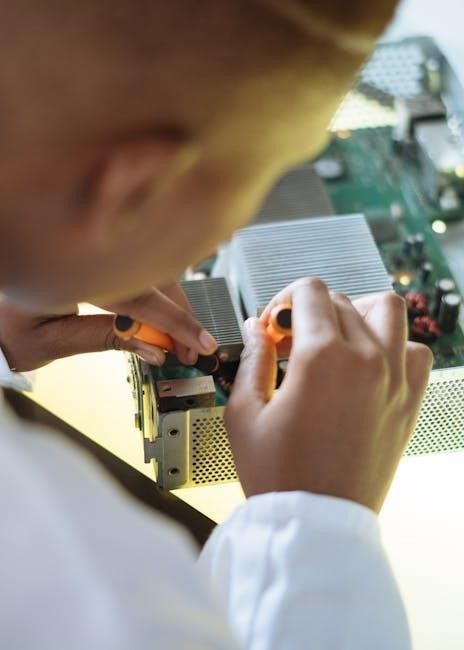The APQP Manual is a comprehensive guide for Advanced Product Quality Planning, focusing on the 3rd edition updates. It standardizes processes across industries, ensuring robust product quality planning and successful launches.
1.1 Purpose of the APQP Manual
The purpose of the APQP Manual is to provide standardized best practices for Advanced Product Quality Planning, developed jointly by Ford, General Motors, and Stellantis. It communicates common processes and requirements for organizations and suppliers to ensure product quality planning aligns with industry standards. The manual serves as a guide to produce a quality plan that supports successful product development, launch, and delivery, ensuring customer satisfaction and compliance with global requirements.
1.2 Scope and Application
The APQP Manual applies to organizations and suppliers across industries, providing a standardized framework for product quality planning. It is widely used in the automotive sector but also applicable in aviation, space, and defense. The manual outlines 17 defined tasks for suppliers to follow, ensuring alignment with global requirements. Its scope includes guiding the development and implementation of quality plans, supporting new product launches, and ensuring compliance with industry standards. This ensures consistency and quality across diverse manufacturing processes and regions;
1.3 Benefits of Implementing APQP
Implementing the APQP Manual offers numerous benefits, including improved product quality, reduced defects, and enhanced customer satisfaction; It streamlines processes, ensuring alignment with industry standards and global requirements. The manual’s structured approach minimizes risks, improves communication, and fosters collaboration across teams. By standardizing best practices, it supports efficient new product launches and continuous improvement. Organizations also gain tools for sourcing risk analysis, change management, and program metrics, enabling better decision-making and operational efficiency. These benefits contribute to long-term success and competitiveness in various industries.
History and Evolution of APQP
The APQP Manual has evolved significantly, with the 3rd edition published in March 2024, decoupling from the Control Plan manual to enhance adaptability and industry alignment.
2.1 Overview of APQP Development
The APQP Manual was developed collaboratively by Ford, General Motors, and Stellantis to standardize best practices for product quality planning. Initially created to harmonize processes across the automotive industry, it has evolved to address emerging challenges. The 3rd edition, released in March 2024, reflects updates driven by industry needs, including agile product management and new sections on sourcing, change management, and risk assessment. This evolution ensures the manual remains relevant, supporting organizations in achieving robust product quality and successful launches.
2.2 Key Changes in the 3rd Edition
The 3rd edition of the APQP Manual introduces significant updates, including the decoupling of the Control Plan content, now a separate manual. New sections focus on sourcing risk analysis, change management, and APQP program metrics. It also emphasizes risk assessment and mitigation plans, aligning with agile product management. Leadership support and ongoing reviews of lessons learned are highlighted, ensuring robust managerial oversight. These changes reflect industry evolution, addressing technological advancements and increasing complexity in product development, while maintaining the core goal of ensuring high-quality product launches.
2.3 Industry Drivers for Updates
Key industry drivers for the APQP Manual updates include technological advancements, electrification, and autonomous driving, which have increased product complexity. The rise of agile methodologies and the need for faster, more adaptable quality planning processes also played a role. Additionally, evolving regulatory requirements and the demand for higher automation in manufacturing drove the necessity for updated standards. These factors underscore the importance of robust quality planning to meet modern industry challenges and ensure compliance with emerging standards, fostering innovation and efficiency in product development.
Key Concepts and Methodology
The APQP Manual outlines a structured approach to product quality planning, emphasizing the 5-phase process, integration with tools like FMEA and SPC, and the critical role of leadership in ensuring continuous improvement and compliance.
3.1 The 5-Phase APQP Process
The 5-Phase APQP Process is a structured methodology for achieving product quality excellence. It includes Planning, Product Design & Development, Process Design & Development, Validation, and Ongoing Production, Use, and Post-Delivery Service. Each phase ensures alignment with customer requirements, robust design, and process control. The process integrates tools like FMEA and SPC, emphasizing continuous improvement and risk mitigation. This systematic approach guarantees a seamless transition from concept to production, ensuring high-quality outcomes and customer satisfaction.
3.2 Integration with Other Quality Tools (FMEA, SPC, PPAP)
The APQP Manual emphasizes the integration of quality tools like FMEA, SPC, and PPAP to enhance product quality planning. FMEA identifies potential failures, while SPC ensures process stability. PPAP validates production readiness, aligning with APQP’s phases. These tools collectively mitigate risks, optimize processes, and ensure compliance with industry standards. Their integration streamlines quality management, fostering a holistic approach to product development and production, ultimately ensuring customer satisfaction and regulatory adherence.
3.3 Role of Leadership and Management
Leadership and management play a critical role in the success of APQP implementation. They must foster a quality-focused culture, allocate resources, and ensure cross-functional collaboration. Leaders are responsible for defining clear goals, monitoring progress, and driving continuous improvement. The APQP Manual emphasizes the importance of leadership support in integrating quality planning into organizational processes. Effective management ensures adherence to standards, while leadership inspires innovation and accountability. This dual focus enables organizations to achieve sustainable quality excellence and customer satisfaction. The 3rd edition further highlights the shift from management to leadership, emphasizing strategic oversight and alignment with industry best practices.
Implementation Requirements
The APQP Manual outlines specific requirements for successful implementation, including General Motors’ global standards, supplier deliverables, and standardized processes across regions to ensure consistency and quality excellence.
4.1 General Motors Global Requirements
General Motors’ global requirements for APQP are standardized to ensure consistency and quality across all regions. The manual outlines 17 defined tasks for suppliers, detailing deliverables and processes to follow. It emphasizes the importance of a robust quality planning process, aligning with GM’s global standards. Effective March 1, 2024, the 3rd Edition APQP Manual is mandatory, replacing earlier versions unless specified otherwise. This ensures suppliers adhere to updated practices, including sourcing risk analysis and change management, fostering a unified approach to product quality planning and launch excellence.
4.2 Supplier Deliverables and Tasks
Suppliers must adhere to specific deliverables and tasks outlined in the APQP Manual. The 3rd Edition requires completion of 17 defined tasks, ensuring alignment with General Motors’ global standards. Deliverables include detailed documentation for each phase of the APQP process, such as risk assessments, change management plans, and program metrics. Suppliers are expected to demonstrate compliance with these requirements, ensuring product quality and adherence to updated practices. This structured approach guarantees consistency and excellence in new product launches, meeting GM’s stringent global expectations.
4.3 Standardization Across Regions
The APQP Manual ensures standardization across regions by creating a common process for all suppliers. Developed by a GM global team, it unifies varying regional practices into a cohesive framework. This standardization guarantees consistency in quality planning, regardless of location. The manual includes defined tasks and deliverables, ensuring alignment with global requirements while allowing flexibility for regional compliance. This approach fosters collaboration and reduces variability, enabling suppliers to meet GM’s expectations seamlessly across different regions and markets.
Advanced Features of the 3rd Edition
The 3rd edition introduces advanced features like sourcing risk analysis, change management, and APQP program metrics. It enhances managerial activities, ensuring robust processes for improved product launches and adaptability.
5.1 Sourcing Risk Analysis
The 3rd edition of the APQP Manual introduces sourcing risk analysis as a key feature to identify and mitigate risks in the supply chain. This proactive approach ensures that potential risks are addressed early, minimizing disruptions and ensuring high-quality outputs. By integrating sourcing risk analysis, organizations can better manage supplier-related challenges, align with industry standards, and maintain robust product quality. This feature is critical for maintaining reliability and consistency in global supply chains, especially in industries with complex sourcing requirements.
5.2 Change Management Processes
The 3rd edition of the APQP Manual emphasizes robust change management processes to ensure seamless transitions during product development. These processes help organizations identify, assess, and implement changes effectively, minimizing disruptions. By aligning with industry standards and best practices, the manual provides structured approaches to manage changes, ensuring compliance and maintaining product quality. This focus on change management enhances collaboration, reduces errors, and supports efficient adaptation to evolving requirements, ultimately improving overall product launch success and customer satisfaction;
5.3 APQP Program Metrics
The APQP Manual introduces detailed program metrics to measure the effectiveness of quality planning processes. These metrics enable organizations to track progress, identify gaps, and ensure alignment with industry standards. The 3rd edition emphasizes the importance of data-driven decision-making, providing clear guidelines for establishing and monitoring key performance indicators. By incorporating these metrics, organizations can improve program execution, reduce variability, and enhance overall product quality. This structured approach ensures accountability and continuous improvement throughout the product development lifecycle.
5.4 Risk Assessment and Mitigation Plans
The 3rd edition of the APQP Manual emphasizes robust risk assessment and mitigation strategies to ensure product quality and reliability. It provides guidelines for identifying, analyzing, and prioritizing risks throughout the product lifecycle. Organizations are encouraged to adopt a proactive approach, integrating risk management with tools like FMEA. The manual outlines structured frameworks for developing mitigation plans, ensuring timely and effective responses to potential issues. This focus on risk management enhances overall product quality, reduces delays, and supports continuous improvement in quality planning processes.
Training and Resources
The APQP Manual is supported by AIAG training courses, eDocuments, and certified distributors. Resources include manuals, guides, and discounted bundles for efficient learning and implementation of quality planning standards.
6.1 AIAG Training Courses
AIAG offers comprehensive training courses to help organizations master the APQP Manual. These courses cover transitioning to the 3rd edition, understanding updated processes, and implementing new standards effectively. Designed for professionals at all levels, the training is reviewed and approved by industry experts who developed the standards. Participants gain hands-on knowledge of advanced product quality planning, including sourcing risk analysis, change management, and program metrics. AIAG also provides eDocuments and discounted bundles for core tools, ensuring learners have access to the latest resources for successful implementation and compliance with industry requirements.
6.2 Access to Manuals and Guides
AIAG provides easy access to the latest APQP Manual and related guides in multiple formats, including PDF and hard copies. The 3rd edition is available in various languages, catering to global users. Discounted bundles for core tools, such as APQP, Control Plan, and PPAP, offer cost-effective solutions. For international users, certified distributors ensure access to hard-copy publications. Additionally, electronic versions of forms and checklists are included in the My Account space post-purchase, enhancing convenience and implementation efficiency for organizations adopting the updated standards.
6.3 Certified Publication Distributors
Certified Publication Distributors are authorized partners of AIAG, ensuring global access to APQP Manual and related core tools. These distributors provide hard-copy publications, training materials, and guides in multiple languages. They cater to international users, offering localized support and resources. By purchasing through certified distributors, organizations ensure they receive authentic, up-to-date materials. This network simplifies access to the latest APQP standards, enabling seamless implementation and compliance with industry requirements. Their role is crucial for global consistency and effective adoption of quality planning practices.
Industry Applications
The APQP Manual is widely applied in the automotive industry but also extends to aviation, space, defense, and other sectors, ensuring standardized quality planning and compliance across diverse fields.
7.1 Automotive Industry Focus
The APQP Manual is primarily developed for the automotive industry by Ford, General Motors, and Stellantis. It standardizes quality planning processes for suppliers, ensuring compliance with industry-specific requirements. The 3rd edition emphasizes updates like sourcing risk analysis and change management, reflecting evolving automotive demands. Its implementation is mandated by major automakers, ensuring alignment with global quality standards and facilitating successful product launches across the automotive supply chain.
7.2 Applications Outside the Automotive Industry
While primarily developed for automotive, the APQP Manual is adaptable to other industries. Its structured 5-phase approach is valuable in aviation, space, and defense, where product quality and reliability are critical. The methodology supports compliance with standards like AS9145, ensuring robust planning and risk mitigation. Industries beyond automotive benefit from its focus on process control, documentation, and continuous improvement, making it a versatile tool for achieving high-quality outcomes across diverse sectors.
7.3 Aviation, Space, and Defense Applications
The APQP Manual is increasingly applied in aviation, space, and defense due to its robust methodology. It aligns with standards like AS9145, ensuring compliance and reliability in high-stakes environments. The 5-phase process supports complex product development, integrating tools like FMEA and PPAP. Its focus on risk mitigation and documentation is critical for meeting stringent regulatory requirements. This structured approach enhances product quality and ensures adherence to industry standards, making it a valuable resource for achieving operational excellence in these demanding sectors.
Related Tools and Standards
The APQP Manual integrates with tools like FMEA, SPC, and PPAP, ensuring comprehensive quality planning. It aligns with standards such as IATF 16949, enhancing process control and compliance.
8.1 Production Part Approval Process (PPAP)
The Production Part Approval Process (PPAP) is a critical tool in the automotive industry, ensuring parts meet quality and design requirements before mass production. It involves submitting documentation, such as design records, test results, and process validation, for approval. PPAP is closely linked with APQP, as it verifies that production processes can consistently produce high-quality parts. The latest editions of the APQP Manual emphasize the importance of PPAP in achieving zero-defect launches and compliance with industry standards like IATF 16949. This process is essential for suppliers to demonstrate readiness for production;
8.2 Control Plan Reference Manual
The Control Plan Reference Manual is a companion document to the APQP Manual, focusing on process control and variability reduction. It provides detailed guidelines for creating and maintaining control plans, which are essential for ensuring production consistency. The manual emphasizes the importance of linking control plans with other quality tools like FMEA and SPC. While historically part of the APQP Manual, the 3rd edition separates it to allow independent updates, reflecting industry advancements and the need for agile quality management. This separation enhances clarity and adaptability in modern manufacturing environments.
8.3 IATF 16949 and Core Tools
The IATF 16949 standard is closely aligned with the APQP Manual, as both focus on automotive quality management. The standard emphasizes defect prevention and continuous improvement, complementing APQP’s structured approach. Core Tools, such as FMEA, SPC, MSA, and PPAP, are integral to both frameworks, ensuring robust process control and compliance. The APQP Manual supports IATF 16949 by providing detailed guidelines for quality planning, enabling organizations to meet certification requirements effectively. This integration ensures a holistic approach to quality management in the automotive industry.
Latest Editions and Updates
The 3rd edition of the APQP Manual was published in March 2024, featuring updates like sourcing risk analysis and change management. It is now decoupled from the Control Plan manual, allowing for more agile updates. Electronic formats are available, enhancing accessibility and streamlining implementation across industries.
9.1 Decoupling of APQP and Control Plan Manuals
The 3rd edition of the APQP Manual has been decoupled from the Control Plan manual, allowing each document to evolve independently. This change enables more agile updates, reflecting industry advancements like electrification and autonomous driving. The separation emphasizes the distinct roles of each manual, ensuring clarity and focus. Electronic formats are now available, improving accessibility and streamlining implementation. This decoupling aligns with the automotive industry’s need for adaptability and efficiency in quality planning and control processes.
9.2 Timely Updates and Industry Adaptations
The 3rd edition of the APQP Manual reflects timely updates to address industry advancements, such as electrification, autonomous driving, and higher automation. These changes ensure the manual remains relevant amid evolving technological demands. The decoupling from the Control Plan manual allows for more frequent and targeted updates, aligning with the automotive industry’s rapid pace of innovation. New sections on sourcing, change management, and risk mitigation further enhance its applicability. Electronic formats and additional resources, like training courses, support seamless implementation and adaptation across global supply chains.
9.4 Electronic Formats and Accessibility
The 3rd edition of the APQP Manual is available in electronic formats, including PDF, enhancing accessibility for global users. AIAG offers eDocuments in multiple languages, ensuring widespread compatibility. Electronic versions allow for easy updates, quick searches, and efficient storage; Additionally, training courses and resources are accessible online, supporting seamless implementation. This digital approach aligns with modern industry needs, reducing reliance on physical copies and enabling faster dissemination of updated standards. The electronic format also supports environmental sustainability and improves user convenience across diverse regions and organizations.
The APQP Manual serves as a cornerstone for quality planning, ensuring successful product launches. Its separation from the Control Plan enhances flexibility, while updates like sourcing and risk management tools align with industry needs, fostering innovation and excellence in quality management.
10.1 Final Thoughts on APQP Implementation
Implementing the APQP Manual is crucial for achieving robust product quality planning. The 3rd edition’s updates, including sourcing risk analysis and change management, enhance its effectiveness. By standardizing processes and aligning with industry trends like electrification and automation, APQP ensures successful product launches. The separation from the Control Plan manual allows for more agile updates, benefiting organizations in automotive and beyond. Adhering to these guidelines fosters innovation, quality, and customer satisfaction, making APQP a cornerstone of modern manufacturing excellence.
10.2 Future of Advanced Product Quality Planning
The future of Advanced Product Quality Planning lies in its adaptability to emerging technologies and industry needs. The 3rd edition’s updates, such as sourcing risk analysis and change management, reflect this evolution. As industries like automotive, aerospace, and defense adopt APQP, its integration with agile methodologies and digital tools will enhance efficiency. The decoupling of APQP and Control Plan manuals ensures more agile updates, aligning with trends like electrification and autonomous systems. Organizations must embrace these advancements to maintain quality excellence and meet evolving customer expectations.


